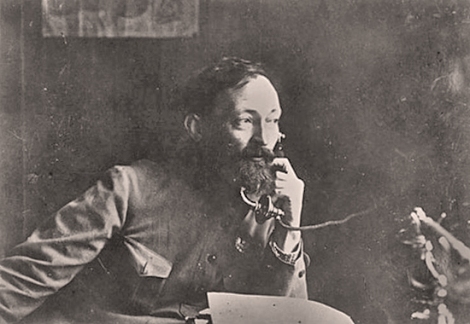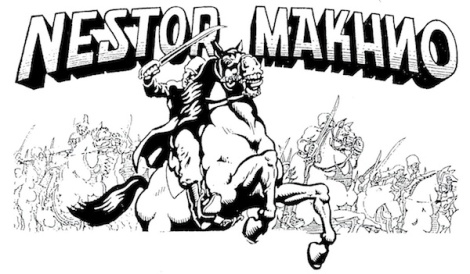Today I continue with selections on anarchism in the Russian Revolution taken from my survey of the historical development and influence of anarchist ideas, the “Anarchist Current,” the Afterword to Volume Three of Anarchism: A Documentary History of Libertarian Ideas. In this selection, I discuss anarchist responses to counter-revolution in Russia, focusing on the struggle for freedom and equality conducted by the “Makhnovist” movement in Ukraine during the Russian Civil War, where the anarchists did battle with the “Whites” (pro-Czarist counter-revolutionaries) and the “Reds” (the Bolsheviks). Although the anarchist insurgency, led by Nestor Makhno, was ultimately defeated, it provided an example of how an anarchist inspired movement for popular liberation could mobilize large numbers of people to take up arms against forces intent on re-establishing state power. I included some Makhnovist proclamations and other material regarding the Makhnovist movement in Volume One of my Anarchism anthology.
Counter-Revolution in Russia
The Russian Revolution raised another issue of fundamental importance to revolutionary anarchists: how to deal with counter-revolution, whether from the left or the right. From 1918 to 1921, Russia was racked by civil war. Many anarchists took the position that in order to protect the gains of the 1917 Revolution, they had no choice but to work with the Bolsheviks (the “Reds”) in preventing Czarist counter-revolutionaries (the “Whites”) from forcing a return to the old order, with all the reprisals and massacres of the revolutionaries that that would entail. According to Paul Avrich, during the civil war “a large majority [of anarchists] gave varying degrees of support to the beleaguered regime,” leading Lenin in 1919 to compliment some anarchists for “becoming the most dedicated supporters of Soviet power” (1978: 196-197).
The Makhnovist Movement
Other anarchists argued that there were alternatives to simply supporting the Bolsheviks in their struggle against the White counter-revolutionaries, thereby strengthening the Bolshevik dictatorship. Instead, they argued for “relentless partisan war, here, there and everywhere,” as Voline put it in February 1918 (Avrich, 1973: 107). But it was only in Ukraine that anarchists were able to instigate a popular insurgency, with the anarchist Nestor Makhno leading a peasant and worker guerrilla army (the “Makhnovshchina”) against a variety of forces, from occupying German and Austrian troops, to local strongmen (the “Hetman”), to the Whites, and when necessary, to the Bolsheviks themselves (Volume One, Selections 85 & 86).
When the Makhnovists liberated an area, they would abolish all decrees issued by the Whites and the Reds, leaving it to “the peasants in assemblies, [and] the workers in their factories and workshops” to decide for themselves how to organize their affairs. The land was to be returned to “those peasants who support themselves through their own labour,” and the “factories, workshops, mines and other tools and means of production” to the workers themselves (Volume One, Selection 85).
The Makhnovists denounced “the bourgeois-landlord authority on the one hand and the Bolshevik-Communist dictatorship on the other.” They would throw out the Bolshevik secret police, the Cheka, from areas that had been under Bolshevik control and reopen the presses and meeting places that the Bolsheviks had shut down, proclaiming that “freedom of speech, press, assembly, unions and the like are inalienable rights of every worker and any restriction on them is a counter-revolutionary act.” The Makhnovists called upon the soldiers of the Red Army, sometimes with some success, to desert and join the Makhnovists in their struggle for “a non-authoritarian labourers’ society without parasites and without commissar-bureaucrats” (Volume One, Selection 85).
Despite their opposition to “state militia, policemen and armies,” which they would declare abolished in the areas they had liberated (Volume One, Selection 85), the Makhnovist insurgents adopted some aspects of more conventional military organization, including a chain of command and conscription, and sometimes carried out “summary executions” (Avrich, 1988: 114 & 121).
Many anarchists who were still free to do so, such as Voline, Aaron Baron and Peter Arshinov, went to Ukraine to support the Makhnovists, setting up the Nabat confederation, one of the more effective anarchist organizations during the Revolution and Civil War. But as Peter Arshinov noted, “three years of uninterrupted civil wars made the southern Ukraine a permanent battlefield,” making it difficult for the anarchists and Makhnovists to accomplish anything positive (Volume One, Selection 86). Yet for five months in early 1919, “the Gulyai-Polye region” where Makhno was based “was virtually free of all political authority,” giving the anarchists a chance, albeit a very brief one, to put their constructive ideas into practice by helping the peasants and workers to set up libertarian communes and soviets (Avrich, 1988: 114).
A “series of Regional Congresses of Peasants, Workers and Insurgents” was held, the third in April 1919, “in defiance of a ban placed upon it” by the Bolsheviks (Avrich, 1988: 114-115). After “two Cheka agents [who] were sent to assassinate Makhno were caught and executed” in May 1919, and the Makhnovists called upon the Red Army soldiers to join them, Trotsky outlawed the Makhnovists, sending in troops to dismantle their peasant communes (Avrich, 1988: 115). Despite subsequent temporary alliances to fight the Whites, by early 1921, the Bolsheviks had crushed the Makhnovist movement.
Unlike the Bolsheviks, the Makhnovists were able to garner significant support among the Ukrainian peasantry, who resented Bolshevik seizures of their grain and food, seeing that “the bread taken by force from [them] nourishes mainly the enormous governmental machine” being created by the Bolsheviks. For the revolution to succeed, the anarchists believed that the masses “must feel truly free; they must know that the work they do is their own; they must see in every social measure which is adopted the manifestation of their will, their hopes and their aspirations” (Volume One, Selection 86).
Robert Graham

Makhnovists




Reblogged this on sergiofalcone.
[…] https://robertgraham.wordpress.com/2015/03/29/the-makhnovist-movement-in-the-russian-revolution/ […]
Sadly, three of the photos have incorrect captions. “Makhnovist tachanka” is actually a Red Army tachanka (Makhnovists would hardly use the slogan “Death to the black bandit”. Makhno himself insisted that the Makhnovists never used banner with skulls, apparently in reference to the third photo. And the cavalry unit is Red Army, not Makhnovist (note the stars on at least two of the caps). Virtually all the authentic Makhnovist photos can be found here: http://www.makhno.ru/photo.php.
Changed two of the photos. Several sources identify the remaining one as a Makhnovist banner. The previous tachanka image allegedly referred to “death to the black bandit baron” Wrangel, the leader of white army counter-revolutionaries.
Although many sources identify the banner being held by two soldiers as Makhnovist, I’m pretty sure they can all be traced back to the same source: the book “Jewish Pogroms: 1917–1921”, ed. Z. S. Ostrovsky (Moscow, 1926). This is a typical atrocity book, with lots of gruesome photos of victims, which depicts the Makhnovists as inveterate pogromists. When Makhno got hold of this book, he wrote the essay “To the Jews of All Countries”, repudiating its attacks on the Makhnovists and specifically denying that the photo in question (found on p. 100) has anything to do with his movement. What particularly incensed Makhno was that the book makes no mention of the all too real pogrom activity perpetrated by the Red First Cavalry Army in 1920.
In 2011 another photo was discovered, showing the reverse side of the banner (you can view it on this thread: http://forum.milua.org/viewtopic.php?f=2&t=12064&start=30). The lettering on the reverse side reads: “Naddnipryansʹkyy Kish”, or Dnieper [Cossack] Headquarters. This indicates that the banner is associated with the Free Cossacks, formations which functioned as an internal police force during the First Ukrainian Government (Central Rada) of 1917–1918. So, despite the slogan, not necessarily a progressive bunch.
Guess I better change that photo too! You sure know your Makhno. Thanks for raising these issues.